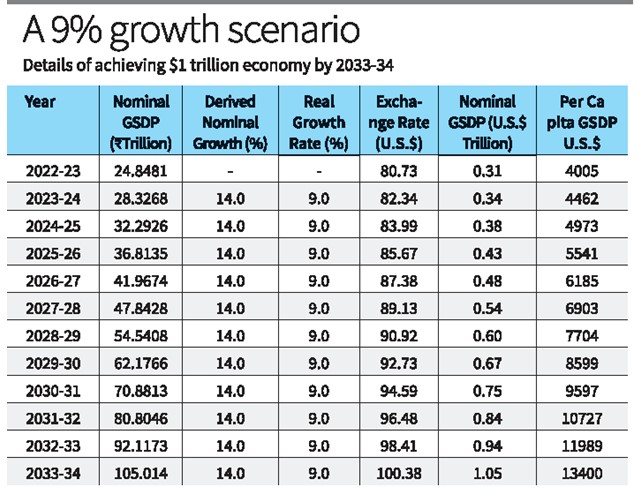- The Chief Minister of Tamil Nadu has set Tamil Nadu the goal of becoming a trillion dollar economy (by 2030), as he has indicated over the past year.
- This is a good aspirational goal. Tamil Nadu’s GDP this year is expected to be equivalent to $0.31 trillion. To reach the goal set by the Chief Minister, Tamil Nadu has to triple the size of its economy.
- If this is the goal, we need to examine what the required annual rate of growth will have to be in conjunction with the period over which this rate should be maintained.
Possible scenarios
- At the outset, the possibility of achieving the status of a trillion dollar economy by 2030-31 has to be ruled out.
- It requires a nominal annual growth rate of 18.2%, and on the assumption of inflation of 5% a real growth rate of 13.2%.
- This is not in the realm of possibility. The Table presents the results for the scenario which may be considered achievable, given the required effort.
- In this scenario, the target is achieved in 2033-34, and for this the required real rate of growth will be 9% per cent. The exchange rate is assumed to depreciate from the present level to ₹100.38 per dollar, that is, a depreciation of 2% per annum.
- The nominal rate of growth required will be 14% and with an assumption of 5% inflation, the real rate required is derived as 9%.
- The higher the exchange rate depreciation, the higher will be the required nominal and real rates of growth.
- Under this scenario, the per capita income of the State in the terminal year will be $13,400, which will be a shade higher than the per capita income of $13,205 required to classify a country as a developed country as of now.
- We examine the feasibility of achieving this real rate of growth in the background of the past performance of the Tamil Nadu economy.
- From 2005-06 to 2011-12, Tamil Nadu registered a strong real growth performance of 10.3% per annum as against an all India growth rate of 8.2%.
- However, its average annual growth declined to 6.43% as against all India growth of 5.48% from 2012-13 to 2021-22.
- Thus the task of achieving a growth rate of 9% per annum over an extended period is not going to be that easy. With a real growth rate of 8%, the target date would get postponed by one more year to 2034-35. We should also keep this in mind as a possible scenario.
The strategy
- We have spelled out, thus, the quantitative implications of Tamil Nadu reaching a trillion dollar-strong economy.
- The government and all other stakeholders need to draw up a suitable strategy of development. Here are some ideas: in agriculture, the State needs to shift towards the cultivation of highly remunerative and less water-intensive crops.
- The food processing industry needs to be given priority attention to prevent excessive production going to waste.
- With respect to industry and services, the emerging sectors such as biotechnology, pharmaceuticals, logistics and advanced information technology need to be identified and detailed plans chalked out. Infrastructure needs, particularly in power, will also expand.
- Exports can act as a stimulus to growth. Currently Tamil Nadu’s exports equal $26 billion.
- Tamil Nadu’s exports as a percent of Gross State Domestic Product (GSDP) are 8.87%. One stated goal of policymakers is to reach a level of $100 billion of exports.
- This means that when Tamil Nadu reaches $1 trillion strong, the exports-GSDP ratio will have to be 10%. Thus, a special drive is needed to raise the exports-GSDP ratio.
- To sustain a rate of growth of 9%, the investment rate required will be 36% of GSDP on the assumption of an Incremental Capital Output Ratio (ICOR) of 4.
- This will have to be financed by domestic savings supplemented by a flow of resources from the rest of India and other countries. Tamil Nadu must be made the investment destination by creating an appropriate environment.

Fiscal balance
- A strong growth over a sustained period can happen only in a stable economic environment. This implies both price stability and fiscal stability.
- Some econometric results show that with 14% nominal growth, the State should work towards a fiscal deficit of less than 3% so that the debt-GSDP ratio stabilises around 18%.
- The Fiscal Responsibility and Budget Management (FRBM) Review Committee had indicated a normative level of 20% for all States.
- What we have presented so far can be described as the arithmetic of achieving a trillion dollar economy by Tamil Nadu.
- What can happen a decade from now depends upon a number of factors. Therefore, any projection over such a long period has to be conditional.
- Perhaps, the most likely scenario is a nominal growth of 14% per annum over the next 10 years which will take Tamil Nadu to become a trillion dollar economy by 2033-34. We spell out some implications of what this journey will demand.
SOURCE: THE HINDU, THE ECONOMIC TIMES, PIB
 Chinmaya IAS Academy – Current Affairs Chinmaya IAS Academy – Current Affairs
Chinmaya IAS Academy – Current Affairs Chinmaya IAS Academy – Current Affairs



